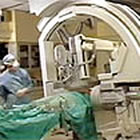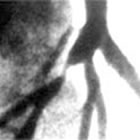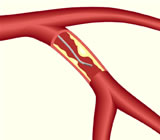 Earlier today, the opening day of EuroPCR, Dr. Bernard De Bruyne presented preliminary results from the FAME II trial which tested the diagnostic power of Fractional Flow Reserve to guide PCI (stenting) of the coronary arteries. I wrote about FAME II back in January, when enrollment in the trial was halted for ethical reasons because the results of the ongoing FAME II trial were showing that the outcomes for stents in patients with stable angina were clearly superior to those in patients who were being treated with medications (a.k.a. Optimal Medical Therapy or OMT) alone. An independent Data Safety Monitoring Board advised that continuing the randomization would not change the findings and so, it was unethical to withhold the option of stents from this patient population. Continue reading
Earlier today, the opening day of EuroPCR, Dr. Bernard De Bruyne presented preliminary results from the FAME II trial which tested the diagnostic power of Fractional Flow Reserve to guide PCI (stenting) of the coronary arteries. I wrote about FAME II back in January, when enrollment in the trial was halted for ethical reasons because the results of the ongoing FAME II trial were showing that the outcomes for stents in patients with stable angina were clearly superior to those in patients who were being treated with medications (a.k.a. Optimal Medical Therapy or OMT) alone. An independent Data Safety Monitoring Board advised that continuing the randomization would not change the findings and so, it was unethical to withhold the option of stents from this patient population. Continue reading
Category Archives: FFR
FAME II: Should Fractional Flow Reserve (FFR) Be Mandatory?
Filed under Appropriate Use Criteria (AUC), COURAGE, FAME I / FAME II, FFR
Q&A with Dr. Jennifer Tremmel of Stanford

Jennifer Tremmel, MD
The Stanford School of Medicine blog “SCOPE” is featuring an “Ask the Doctor About Women’s Heart Health” article. The doctor is Jennifer Tremmel, MD, Clinical Director of Women’s Heart Health at Stanford Clinic, and Dr. Tremmel is no stranger to us here at Angioplasty.Org. You can read our interview with Dr. Tremmel about her experience starting the transradial approach to angioplasty at Stanford (she is also Director of Transradial Intervention there). Continue reading
Filed under FFR, Myocardial Bridging
Stent-Trek: The Next Generation

Starship Stenterprise
Yeah. I went there. Since everyone from Motley Fool to MassDevice to the Wall Street Journal feels the need to use “Stent Wars” (a pun that I originated on this website a decade ago) I’ve decided to go all TV. Actually, “The Next Generation” is also a more appropriate reference than the “Wars” moniker, because the story here is no longer so much about behemoth entities and dark lords battling each other for control of the universe (not that this aspect has gone away) but a story of refinement, sleeker technology and, yes, much more Data! And this past couple of weeks has seen some important developments in the next generation of stents that are positive for both patients and physicians. Continue reading
FAME II is Not the “Anti-COURAGE”: Stents and Angioplasty in the Spotlight
 There’s been much talk this week in the interventional cardiology community (and among stock market analysts) about stents and angioplasty, given the news that the FAME II clinical trial ended enrollment early, due to ethical concerns that were generated by the fact that patients randomized to Optimal Medical Therapy (OMT) alone were returning to the hospital in significant numbers for “urgent revascularization”, i.e. stenting!
There’s been much talk this week in the interventional cardiology community (and among stock market analysts) about stents and angioplasty, given the news that the FAME II clinical trial ended enrollment early, due to ethical concerns that were generated by the fact that patients randomized to Optimal Medical Therapy (OMT) alone were returning to the hospital in significant numbers for “urgent revascularization”, i.e. stenting!
So is this, as several analysts have suggested, a reversal of the COURAGE trial results? Not according to the principal investigators of both the FAME II trial AND the COURAGE trial, whom I have spoken with in the past 48 hours. Continue reading
Filed under Clinical Trials / Studies, COURAGE, FAME I / FAME II, FFR
Does FAME II Trump COURAGE? FFR: Key to Stents and Angioplasty
 Positive news today from St. Jude Medical (NYSE:STJ) about FFR as a clinical decision-making tool. The company announced that it is stopping enrollment in its FAME II trial after only 2/3 of the planned patients were included. Why? Because the interim data so clearly favor the use of Fractional Flow Reserve (FFR) to guide stenting (PCI) in stable angina patients that the independent Data Safety Monitoring Board (DSMB) for the trial has concluded that it would be unethical to continue to randomize patients to optimal medical therapy (OMT) alone. Turns out that patients receiving OMT only experienced a highly statistically significant increased risk of hospital readmission and urgent revascularization.
Positive news today from St. Jude Medical (NYSE:STJ) about FFR as a clinical decision-making tool. The company announced that it is stopping enrollment in its FAME II trial after only 2/3 of the planned patients were included. Why? Because the interim data so clearly favor the use of Fractional Flow Reserve (FFR) to guide stenting (PCI) in stable angina patients that the independent Data Safety Monitoring Board (DSMB) for the trial has concluded that it would be unethical to continue to randomize patients to optimal medical therapy (OMT) alone. Turns out that patients receiving OMT only experienced a highly statistically significant increased risk of hospital readmission and urgent revascularization.
Wait a minute! Did they say that using optimal medical therapy alone was unethical for the treatment of stable angina patients? That’s pretty big news! Continue reading
Filed under COURAGE, FAME I / FAME II, FFR, Stent
iFR: A New Way to Judge Stents and Angioplasty for Coronary Blockages?
 For several years now, I’ve been advocating for expanded use of functional measurement, otherwise known as Fractional Flow Reserve (FFR), as a way of determining whether or not a blocked artery is actually causing ischemia. A new measurement, made possible by recent advances in computer technology, called iFR (instant wave-Free Ratio™) may provide the momentum that pushes this concept into mainstream cardiology. Continue reading
For several years now, I’ve been advocating for expanded use of functional measurement, otherwise known as Fractional Flow Reserve (FFR), as a way of determining whether or not a blocked artery is actually causing ischemia. A new measurement, made possible by recent advances in computer technology, called iFR (instant wave-Free Ratio™) may provide the momentum that pushes this concept into mainstream cardiology. Continue reading
Filed under FFR, Imaging, Interviews
Fractional Flow Reserve: A “How-To” Guide for Cardiologists
 I’ve written a lot about Fractional Flow Reserve, or FFR, in the past — and the fact that it’s a simple tool that can be used during an angiogram to assess the actual obstruction to the volume of blood flow being caused by an arterial blockage. Sure you can SEE a blockage on the fluoroscopic image, but should you stent it?
I’ve written a lot about Fractional Flow Reserve, or FFR, in the past — and the fact that it’s a simple tool that can be used during an angiogram to assess the actual obstruction to the volume of blood flow being caused by an arterial blockage. Sure you can SEE a blockage on the fluoroscopic image, but should you stent it?
The results of the by now well-known FAME study indicate that a third of the blockages between 50% and 90% (as seen on the angiogram) actually had an FFR measurement of greater than 80% (meaning that the obstruction of flow was less than 20%, even though the blockage looked more significant on the angiogram). Most importantly, treating those blockages with angioplasty and stenting resulted in worse outcomes at one year — results which have remained constant now three years later. For more information, read our exclusive interview with Dr. Nico Pijls, co-principal investigator for FAME. Continue reading
Filed under Angiograms, FAME I / FAME II, FFR



